Construction of Chitosan-Zn-Based Electrochemical Biosensing Platform for Rapid and Accurate Assay of Actin
Abstract
1. Introduction
2. Experiments Section
2.1. Reagents
2.2. Synthesis of Zn NPs
2.3. Synthesis of Chitosan-Zn NPs
2.4. Characterization
2.5. Preparation of Anti-Actin/Chitosan-Zn Modified GCE
2.6. Electrochemical Detection
2.7. Preparation of HSP90
2.8. Preparation and Determination of Actin
3. Results and Discussion
3.1. Characterization
3.2. SDS-PAGE of the Extracted Actin
3.3. Biocompatibility
3.4. Optimization of Experimental Parameters
3.5. Electrochemical Behavior of Modified Electrode
3.6. Actin Determination
3.7. Interference
3.8. Sensing Applications for Real Samples
4. Conclusions
Author Contributions
Funding
Conflicts of Interest
Appendix A
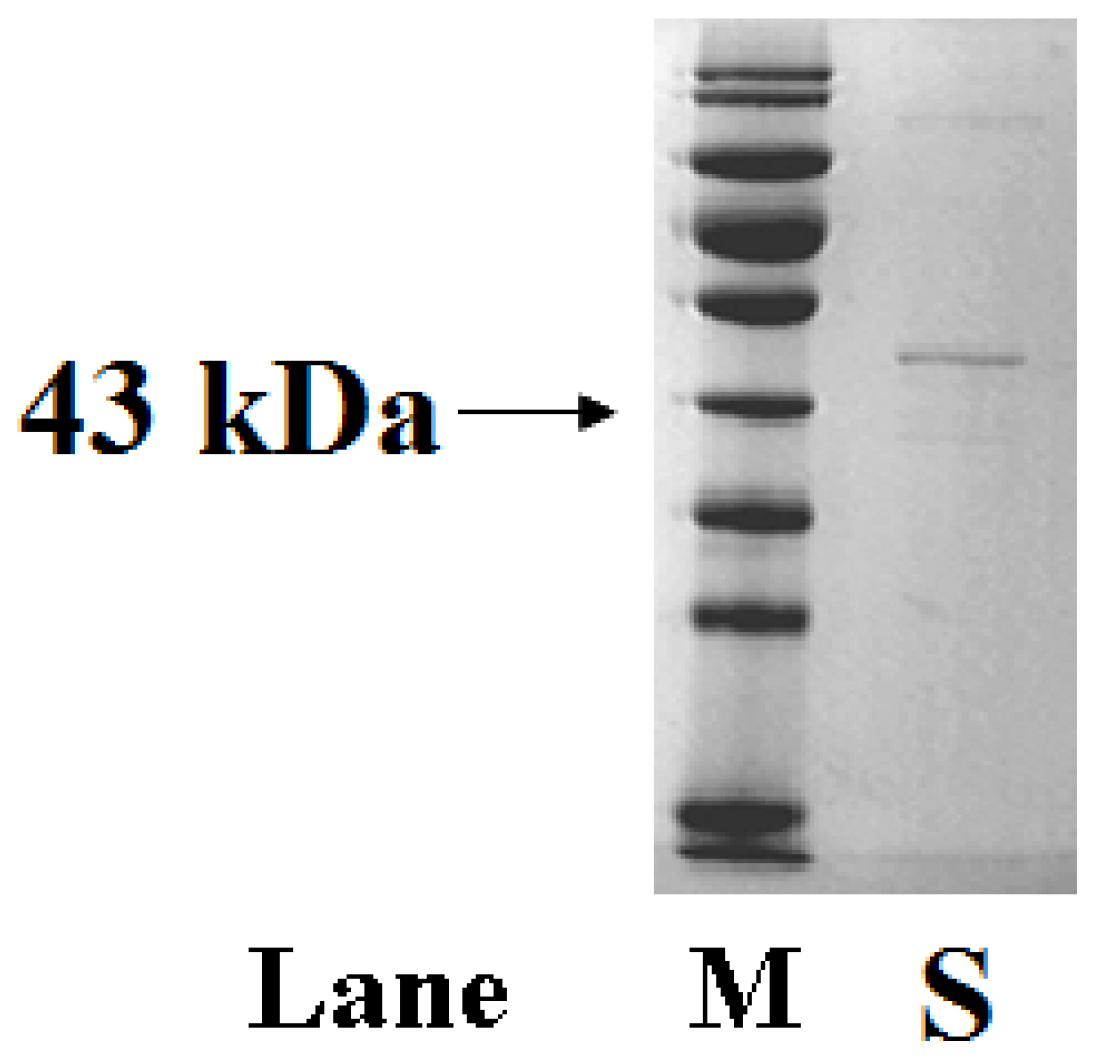
References
- Fritzsche, M.; Fernandes, R.A.; Chang, V.T.; Colin-York, H.; Clausen, M.P.; Felce, J.H.; Galiani, S.; Erlenkamper, C.; Santos, A.M.; Heddleston, J.M.; et al. Cytoskeletal actin dynamics shape a ramifying actin network underpinning immunological synapse formation. Sci. Adv. 2017, 3, e1603032. [Google Scholar] [CrossRef] [PubMed]
- Nandelstadh, P.; Gucciardo, E.; Lohi, J.; Li, R.; Sugiyama, N.; Carpen, O.; Lehti, K. Actin-associated protein palladin promotes tumor cell invasion by linking extracellular matrix degradation to cell cytoskeleton. Mol. Biol. Cell 2014, 25, 2556–2570. [Google Scholar] [CrossRef] [PubMed]
- Dang, C.G.; Cho, S.H.; Sharma, A.; Kim, H.C.; Jeon, G.J.; Yeon, S.H.; Hong, S.K. Genomewide association study for WarnerBratzler shear force and sensory traits in Hanwoo (Korean cattle). AsianAustralas J. Anim. Sci. 2014, 27, 1328–1335. [Google Scholar] [PubMed]
- Okitani, A.; Ichinose, N.; Itoh, J.; Tsuji, Y.; Oneda, Y.; Hatae, K.; Migita, K.; Matsuishi, M. Liberation of actin from actomyosin in meats heated to 65 °C. Meat Sci. 2009, 81, 446–450. [Google Scholar] [CrossRef] [PubMed]
- Li, S.; Xu, X.; Zhou, G. The roles of the actin-myosin interaction and proteolysis in tenderization during the aging of chicken muscle. Poult. Sci. 2012, 91, 150–160. [Google Scholar] [CrossRef] [PubMed]
- Yao, Y.F.; Lacroix, D.; Mak, A.F.T. Effects of oxidative stress-induced changes in the actin cytoskeletal structure on myoblast damage under compressive stress: Confocal-based cell-specific finite element analysis. Biomech. Model Mechanobiol. 2016, 15, 1495–1508. [Google Scholar] [CrossRef] [PubMed]
- Platet, N.; Hinkel, I.; Richert, L.; Murdamoothoo, D.; Moufok-Sadoun, A.; Vanier, M.; Lavalle, P.; Gaiddon, C.; Vautier, D.; Freund, J.N.; et al. The tumor suppressor CDX2 opposes pro-metastatic biomechanical modifications of colon cancer cells through organization of the actin cytoskeleton. Cancer Lett. 2017, 386, 57–64. [Google Scholar] [CrossRef] [PubMed]
- Cao, F.; Zhou, Z.K.; Pan, X.X.; Leung, C.; Xie, W.; Collingridge, G.; Jia, Z.P. Developmental regulation of hippocampal long-term depression by cofilin-mediated actin reorganization. Neuropharmacology 2017, 112, 66–75. [Google Scholar] [CrossRef] [PubMed]
- Wu, D.D.; Yu, D.H.; Wang, X.X.; Yu, B.Z. F-actin rearrangement is regulated by mTORC2/Akt/Girdin in mouse fertilized eggs. Cell Proliferat. 2016, 49, 740–750. [Google Scholar] [CrossRef] [PubMed]
- Kim, H.R.; Leavis, P.C.; Graceffa, P.; Gallant, C.; Morgan, K.G. A new method for direct detection of the sites of actin polymerization in intact cells and its application to differentiated vascular smooth muscle. Am. J. Physiol. Cell Physiol. 2010, 299, 988–993. [Google Scholar] [CrossRef] [PubMed]
- Shimozawa, T.; Ishiwata, S. Mechanical distortion of single actin filaments induced by external force: Detection by fluorescence imaging. Biophys. J. 2009, 96, 1036–1044. [Google Scholar] [CrossRef] [PubMed]
- Inamoto, T.; Namba, M.; Qi, W.M.; Yamamoto, K.; Yokoo, Y.; Miyata, H.; Kawano, J.; Yokoyama, T.; Hoshi, N.; Kitagawa, H. An immunohistochemical detection of actin and myosin in the indigenous bacteria adhering sites of microvillous columnar epithelial cells in peyer’s patches and intestinal villi in the rat jejunoileum. J. Vet. Med. Sci. 2018, 70, 1153–1158. [Google Scholar] [CrossRef]
- Jin, S.; Kennedy, R.T. New developments in Western blot technology. Chin. Chem. Lett. 2015, 26, 416–418. [Google Scholar] [CrossRef]
- Melo, A.M.A.; Dalila, L.; Furtado, R.F.; Borges, M.F. Electrochemical immunosensors for Salmonella detection in food. Appl. Microbiol. Biotechnol. 2016, 100, 5301–5312. [Google Scholar] [CrossRef] [PubMed]
- Mehta, J.; Bhardwaj, N.; Bhardwaj, S.K.; Tuteja, S.K. Graphene quantum dot modified screen printed immunosensor for the determination of parathion. Anal. Chem. 2017, 523, 1–9. [Google Scholar] [CrossRef] [PubMed]
- Liu, N.; Nie, D.X.; Tan, Y.L.; Zhao, Z.Y.; Liao, Y.C.; Wang, H. An ultrasensitive amperometric immunosensor for zearalenones based on oriented antibody immobilization on a glassy carbon electrode modified with MWCNTs and AuPt nanoparticles. Microchim. Acta 2017, 184, 147–153. [Google Scholar] [CrossRef]
- Hsueh, Y.S.; Subramaniam, S.; Tseng, Y.C.; Chiang, T.M.; Mestak, O.; Cheng, T.K.; Kuo, T.F.; Sivasubramanian, S.; Lin, F.H.; Shieh, M.J. In vitro and in vivo assessment of chitosan modified urocanic acid as gene carrier. Mater. Sci. Eng. C 2017, 70, 599–606. [Google Scholar] [CrossRef] [PubMed]
- Vellakkat, M.; Hundekal, D. Electrical conductivity and supercapacitor properties of polyaniline/chitosan/nickel oxide honeycomb nanocomposite. J. Appl. Polym. Sci. 2017, 134, 1–12. [Google Scholar] [CrossRef]
- Feng, Y.M.; Kopplin, G.; Sato, K.; Draget, K.I.; Varum, K.M. Alginate gels with a combination of calcium and chitosan oligomer mixtures as crosslinkers. Carbohyd. Polym. 2017, 156, 490–497. [Google Scholar] [CrossRef] [PubMed]
- Abiraman, T.; Ramanathan, E.; Kavitha, G.; Rengasamy, R.; Balasubramanian, S. Synthesis of chitosan capped copper oxide nanoleaves using high intensity (30 kHz) ultrasound sonication and their application in antifouling coatings. Ultrason. Sonochem. 2017, 34, 781–791. [Google Scholar] [CrossRef] [PubMed]
- Xiao, C.W.; Liu, X.J.; Mao, S.M.; Zhang, L.J.; Lu, J. Sub-micron-sized polyethylenimine-modified polystyrene/Fe3O4/chitosan magnetic composites for the efficient and recyclable adsorption of Cu(II) ions. Appl. Surf. Sci. 2017, 394, 378–385. [Google Scholar] [CrossRef]
- Habiba, U.; Afifi, A.M.; Salleh, A.; Ang, B.C. Chitosan/(polyvinyl alcohol)/zeolite electrospun composite nanofibrous membrane for adsorption of Cr6+, Fe3+ and Ni2+. J. Hazard. Mater. 2017, 322, 182–194. [Google Scholar] [CrossRef] [PubMed]
- Zhao, S.Y.; You, B.; Jiang, L.L. Oriented assembly of zinc oxide mesocrystal in chitosan and applications for glucose biosensors. Cryst. Growth Des. 2016, 16, 3359–3365. [Google Scholar] [CrossRef]
- Xia, J.F.; Cao, X.Y.; Wang, Z.H.; Yang, M.; Zhang, F.F.; Lu, B.; Li, F.; Xia, L.; Li, Y.H.; Xia, Y.Z. Molecularly imprinted electrochemical biosensor based on chitosan/ionic liquid-graphene composites modified electrode for determination of bovine serum albumin. Sens. Actuators B 2016, 225, 305–311. [Google Scholar] [CrossRef]
- Xia, X.H.; Zheng, Z.X.; Zhang, Y.; Zhao, X.J.; Wang, C.M. Synthesis of Ag-MoS2/chitosan nanocomposite and its application for catalytic oxidation of tryptophan. Sens. Actuators B 2014, 192, 42–50. [Google Scholar] [CrossRef]
- Dehdashtian, S.; Gholivand, M.B.; Shamsipur, M.; Kariminia, S. Construction of a sensitive and selective sensor for morphine using chitosan coated Fe3O4 magnetic nanoparticle as a modifier. Mat. Sci. Eng. C 2016, 58, 53–59. [Google Scholar] [CrossRef] [PubMed]
- Tiwari, I.; Singh, M.; Pandey, C.M.; Sumana, G. Electrochemical detection of a pathogenic Escherichia coli specific DNA sequence based on a graphene oxide-chitosan composite decorated with nickel ferrite nanoparticles. RSC Adv. 2015, 5, 67115–67124. [Google Scholar] [CrossRef]
- Amiri, M.; Salehniya, H.; Habibi-Yangjeh, A. Graphitic carbon nitride/chitosan composite for adsorption and electrochemical determination of mercury in real samples. Ind. Eng. Chem. Res. 2016, 55, 8114–8122. [Google Scholar] [CrossRef]
- Yu, L.Y.; Liu, Q.; Wu, X.W.; Jiang, X.Y.; Yu, J.G.; Chen, X.Q. Chiral electrochemical recognition of tryptophan enantiomers at a multi-walled carbon nanotube-chitosan composite modified glassy carbon electrode. RSC Adv. 2015, 5, 98020–98025. [Google Scholar] [CrossRef]
- Deng, F.M.; He, Y.G.; Shi, G.L.; Li, B.; Wu, X. Low-temperature cataluminescence sensor for sulfur hexafluoride utilizing coral like Zn-doped SnO2 composite. Sens. Actuators B 2016, 237, 120–126. [Google Scholar] [CrossRef]
- Li, X.P.; Zhai, Y.C.; Ma, P.H.; Zhao, R.X. Preparation and photocatalysis of nano-Zn/Ce composite oxides. Aust. J. Chem. 2014, 67, 657–662. [Google Scholar] [CrossRef]
- Pandiselvi, K.; Thambidurai, S. Chitosan-ZnO/polyanilne nanocomposite modified glassy carbon electrode for selective detection of dopamine. Int. J. Biol. Macromol. 2014, 67, 270–278. [Google Scholar] [CrossRef] [PubMed]
- Wang, X.H.; Du, Y.M.; Liu, H. Preparation, characterization and antimicrobial activity of Chitosan-Zn complex. Carbohyd. Polym. 2004, 56, 21–26. [Google Scholar] [CrossRef]
- Pathania, D.; Gupta, D.; Kothiyal, N.C.; Sharma, G.; Eldesoky, G.E.; Naushad, M. Preparation of a novel chitosan-g-poly(acrylamide)/Zn nanocomposite hydrogel and its applications for controlled drug delivery of of loxacin. Int. J. Biol. Macromol. 2016, 84, 340–348. [Google Scholar] [CrossRef] [PubMed]
- Halfen, J.A.; Young, V.G. Efficient preparation of 1,4,8-trimethylcyclam and its conversion into a thioalkyl-pendant pentadentate chelate. Chem. Commun. 2003, 2894–2895. [Google Scholar] [CrossRef]
- Sun, C.; Zhang, M.H.; Fei, Q.Q.; Wang, D.Y.; Sun, Z.Z.; Geng, M.; Xu, W.M.; Liu, F. Graphite-like g-C3N4-F127-Au nanosheets used for sensitivemonitoring of heat shock protein. Sens. Actuators B 2018, 256, 160–166. [Google Scholar] [CrossRef]
- Zou, Y.; Xu, P.P.; Wu, H.H.; Zhang, M.H.; Sun, Z.L.; Sun, C.; Wang, D.Y.; Cao, J.X.; Xu, W. Effects of different ultrasound power on physicochemical property and functional performance of chicken actomyosin. Int. J. Biol. Macromol. 2018, 113, 640–647. [Google Scholar] [CrossRef] [PubMed]
- Mohaddeseh, A.A.; Jahan, B.R.; Filip, K.; Karolien, D.W. Mixed hemi/ad-micelles coated magnetic nanoparticles for the entrapment of hemoglobin at the surface of a screen-printed carbon electrode and its direct electrochemistry and electrocatalysis. Biosens. Bioelectron. 2015, 74, 518–525. [Google Scholar]
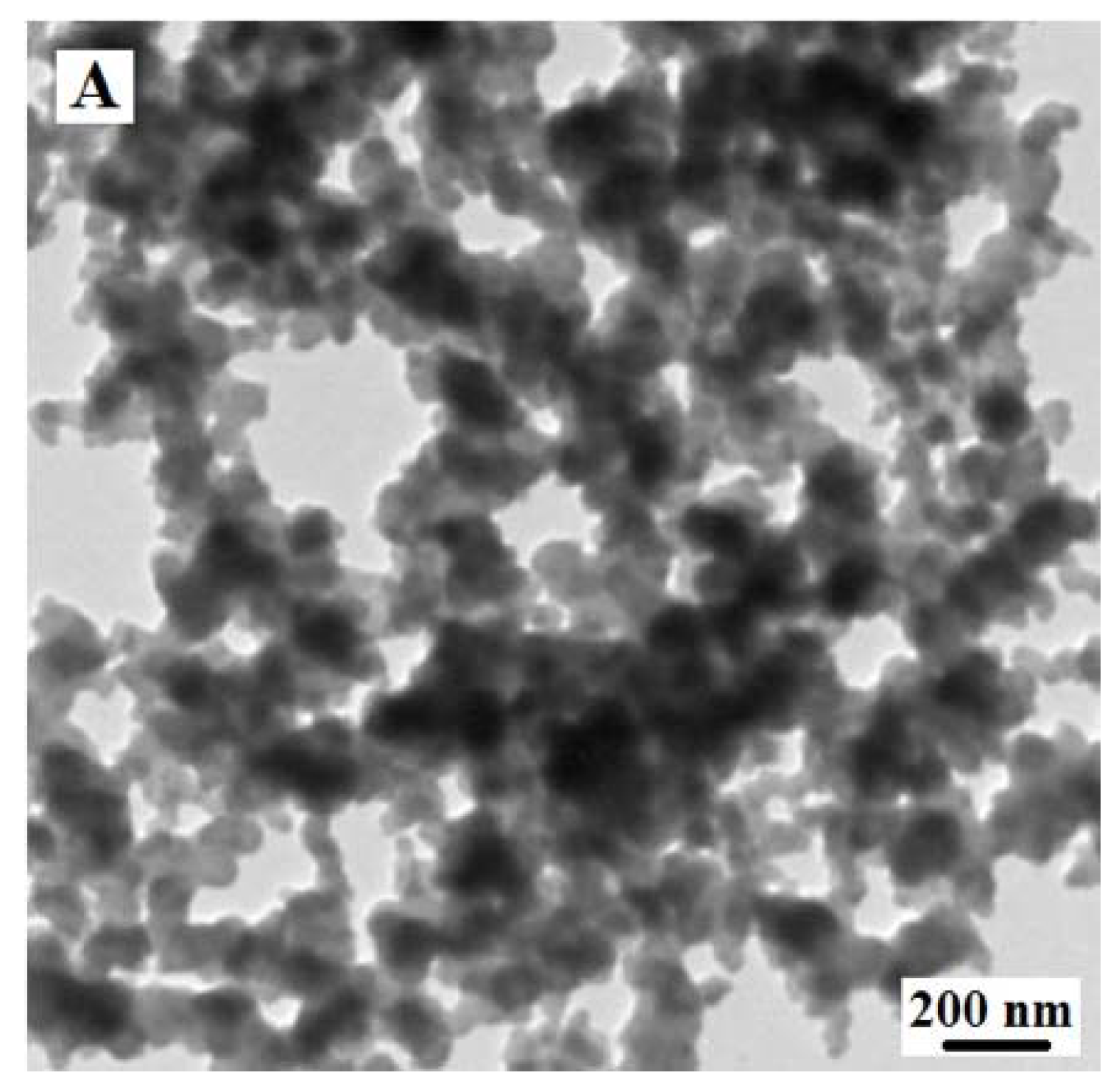
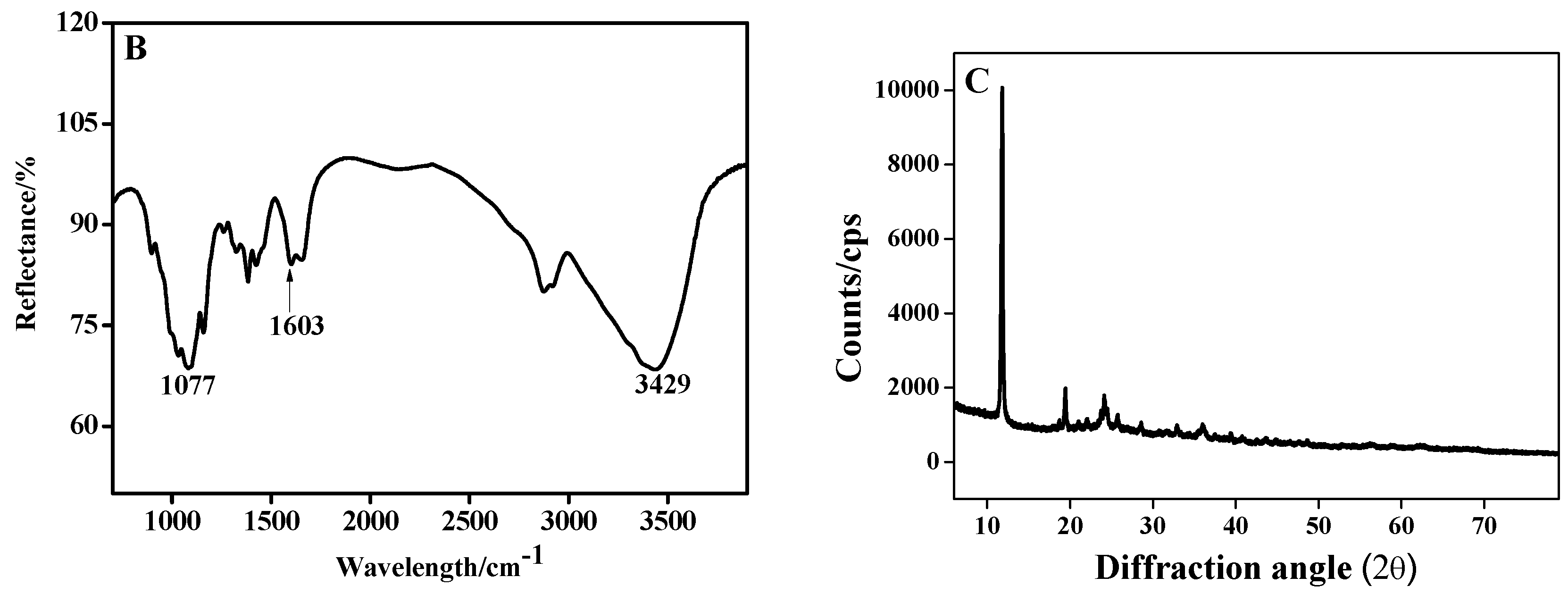
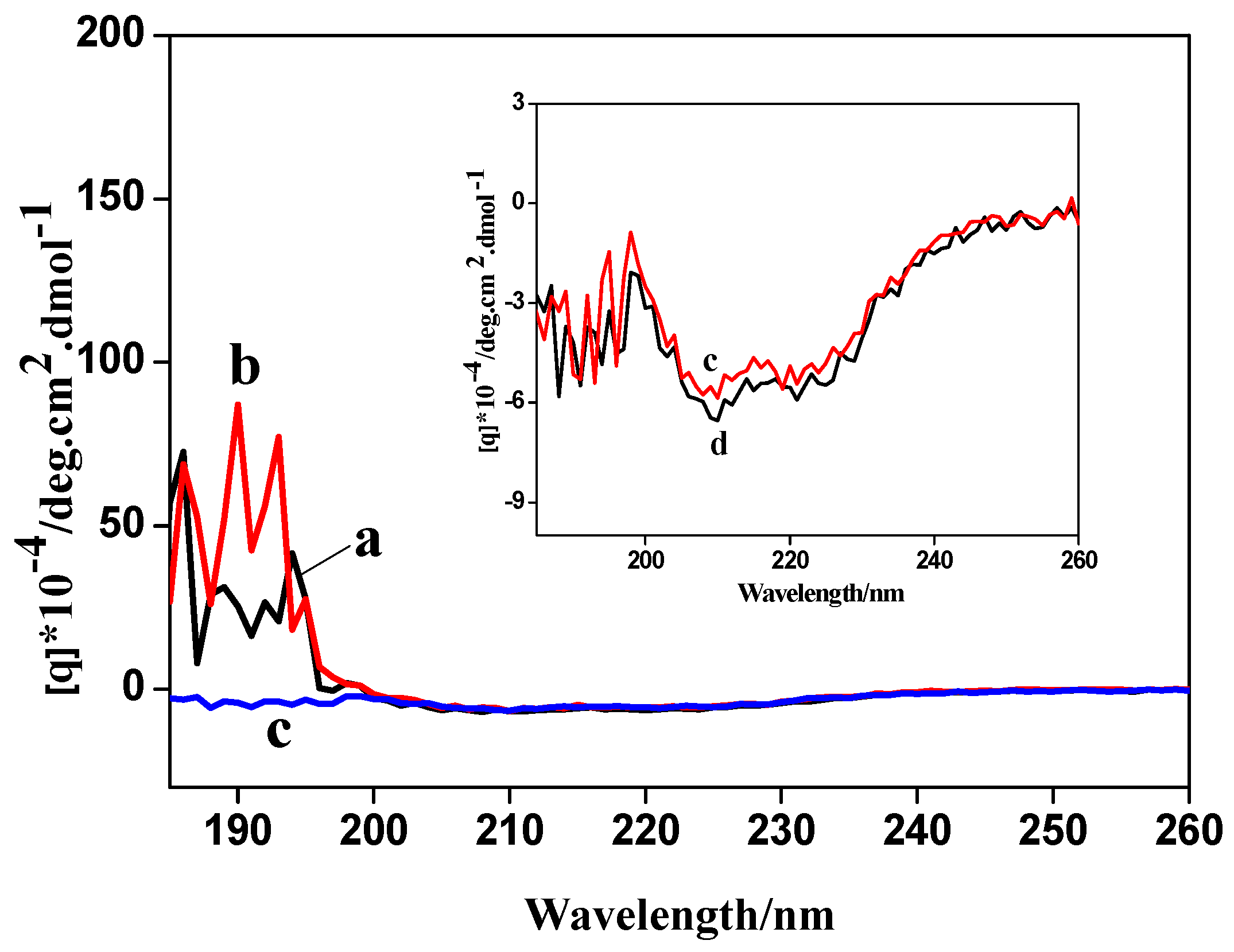
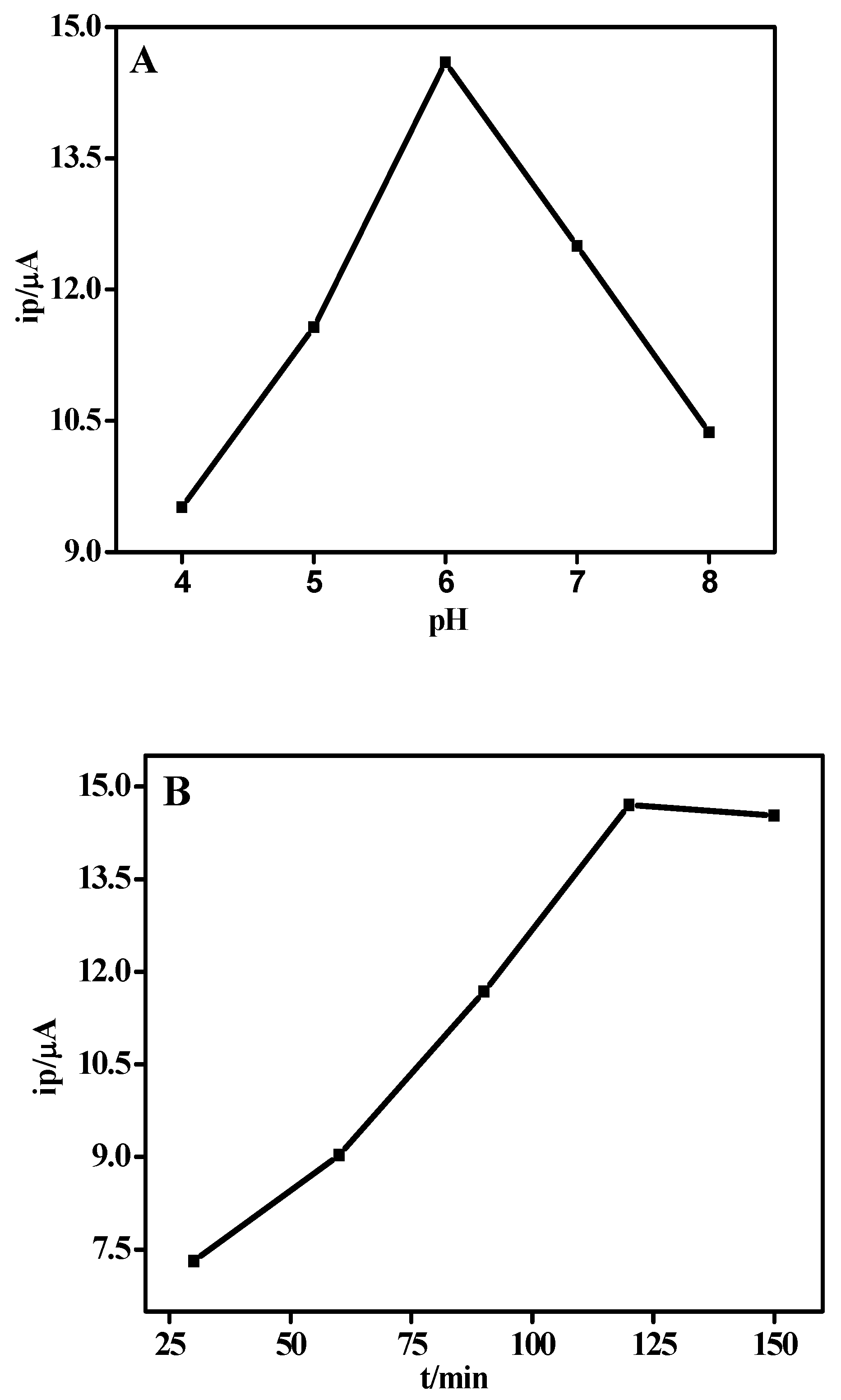
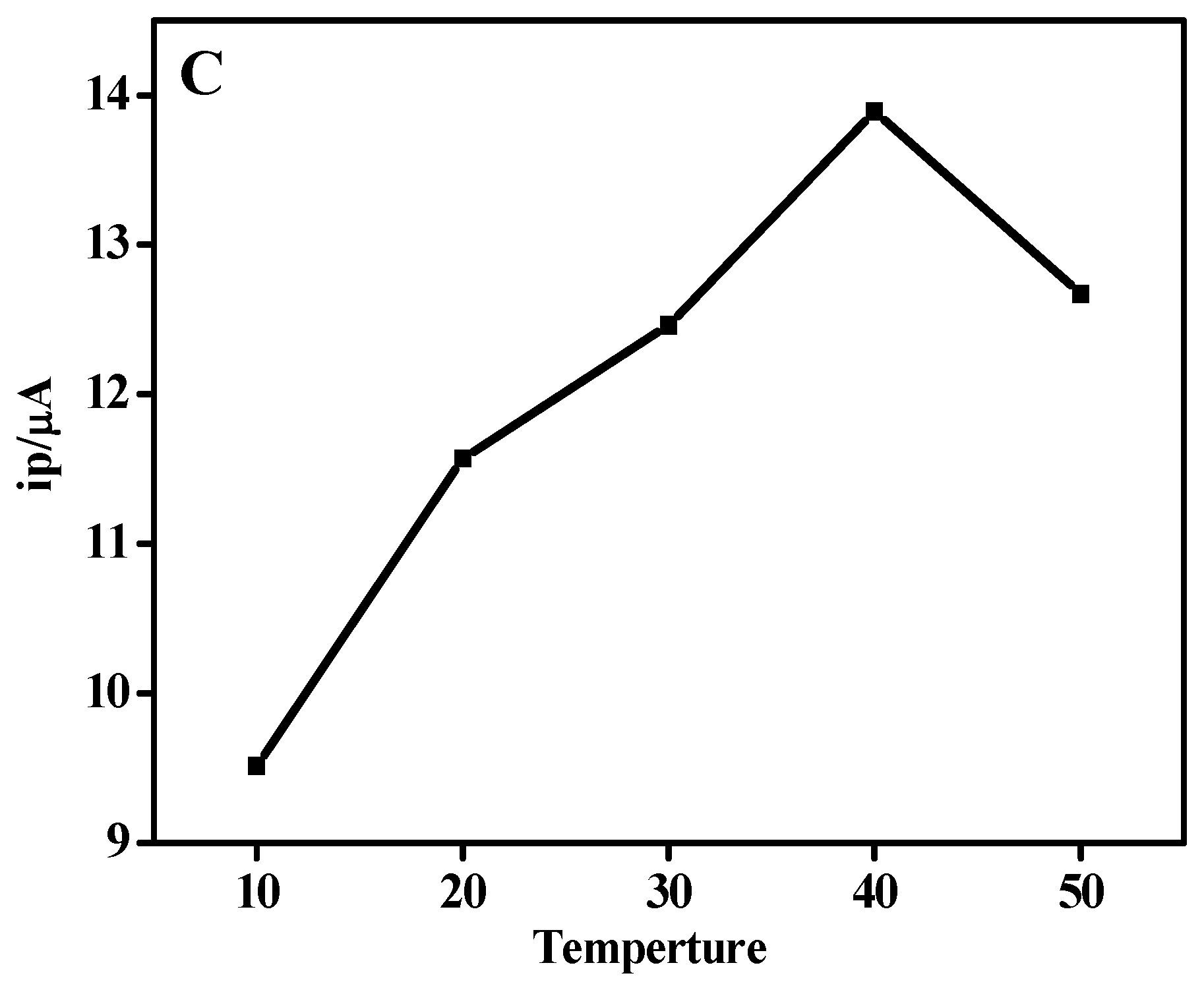
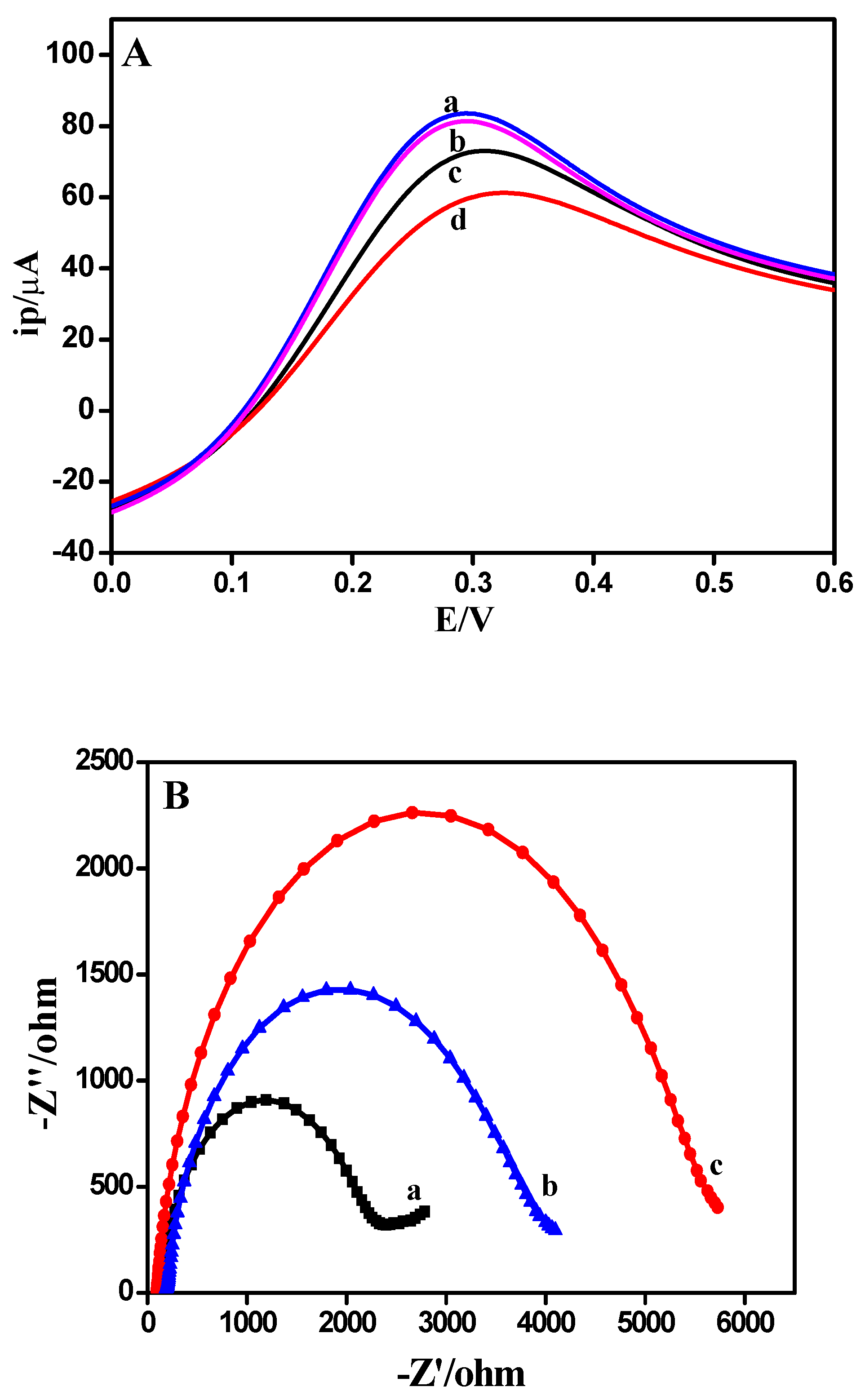

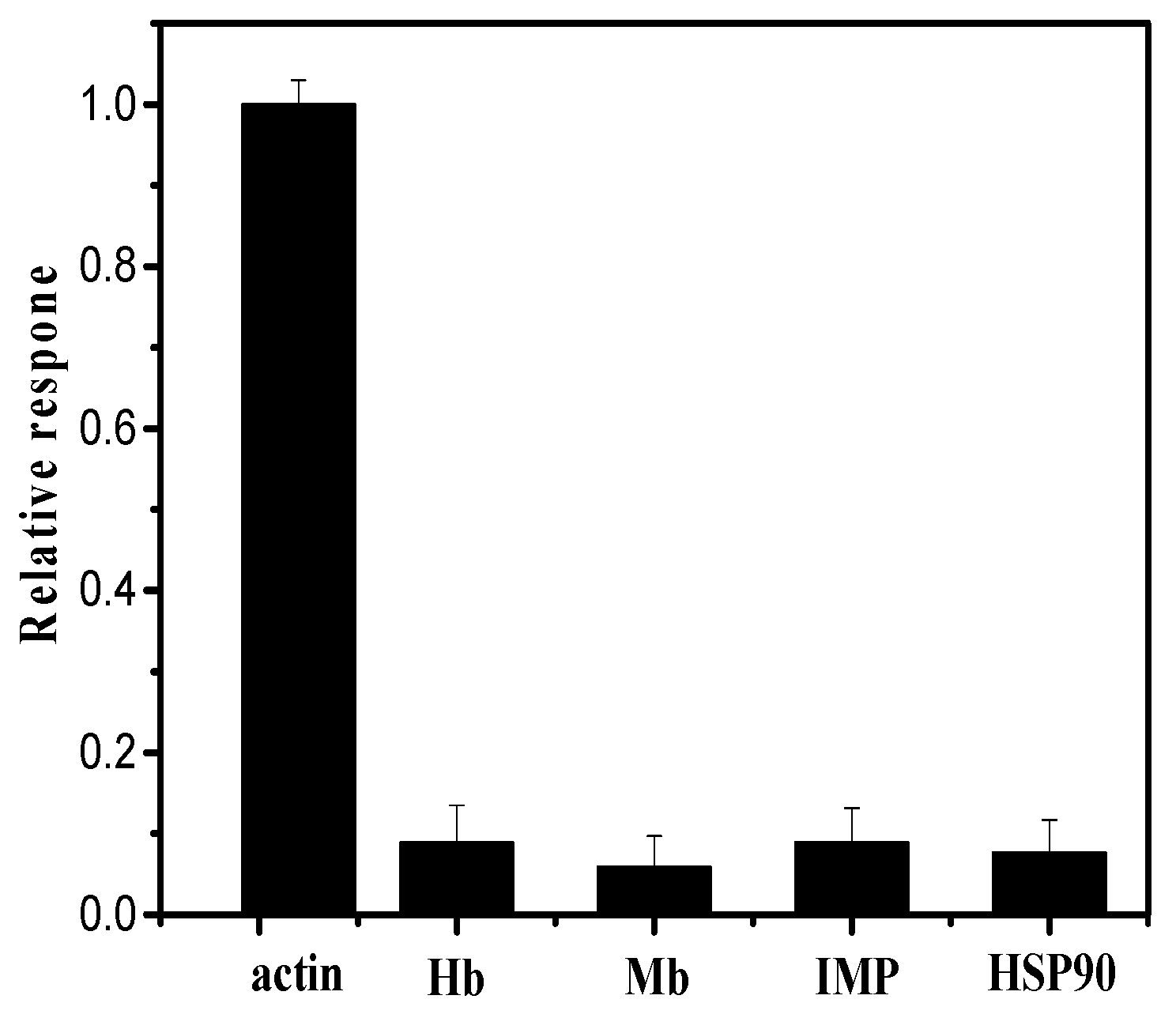
| Samples | Muscle-1 | Muscle-2 | Muscle-3 | Muscle-4 |
|---|---|---|---|---|
| Bradford method (mg/g) | 33.5 ± 3.82 | 37.4 ± 4.11 | 29.4 ± 3.45 | 30.3 ± 4.15 |
| Immunosensor (mg/g) | 34.6 ± 2.15 | 38.5 ± 2.56 | 30.1 ± 2.14 | 31.0 ± 2.72 |
| Samples | Found before Adding (mg/g) | Added (mg/g) | Found after Adding (mg/g) | Recovery (%) | RSD (n = 6) |
|---|---|---|---|---|---|
| Goose breast meat | 32.3 | 10.0 | 41.7 | 98.6 | 2.03 |
| Duck breast meat | 33.5 | 10.0 | 42.4 | 97.4 | 1.96 |
| Chicken breast meat | 30.1 | 10.0 | 39.2 | 97.8 | 2.23 |
© 2018 by the authors. Licensee MDPI, Basel, Switzerland. This article is an open access article distributed under the terms and conditions of the Creative Commons Attribution (CC BY) license (http://creativecommons.org/licenses/by/4.0/).
Share and Cite
Sun, C.; Zou, Y.; Wang, D.; Geng, Z.; Xu, W.; Liu, F.; Cao, J. Construction of Chitosan-Zn-Based Electrochemical Biosensing Platform for Rapid and Accurate Assay of Actin. Sensors 2018, 18, 1865. https://doi.org/10.3390/s18061865
Sun C, Zou Y, Wang D, Geng Z, Xu W, Liu F, Cao J. Construction of Chitosan-Zn-Based Electrochemical Biosensing Platform for Rapid and Accurate Assay of Actin. Sensors. 2018; 18(6):1865. https://doi.org/10.3390/s18061865
Chicago/Turabian StyleSun, Chong, Ye Zou, Daoying Wang, Zhiming Geng, Weimin Xu, Fang Liu, and Jinxuan Cao. 2018. "Construction of Chitosan-Zn-Based Electrochemical Biosensing Platform for Rapid and Accurate Assay of Actin" Sensors 18, no. 6: 1865. https://doi.org/10.3390/s18061865
APA StyleSun, C., Zou, Y., Wang, D., Geng, Z., Xu, W., Liu, F., & Cao, J. (2018). Construction of Chitosan-Zn-Based Electrochemical Biosensing Platform for Rapid and Accurate Assay of Actin. Sensors, 18(6), 1865. https://doi.org/10.3390/s18061865




